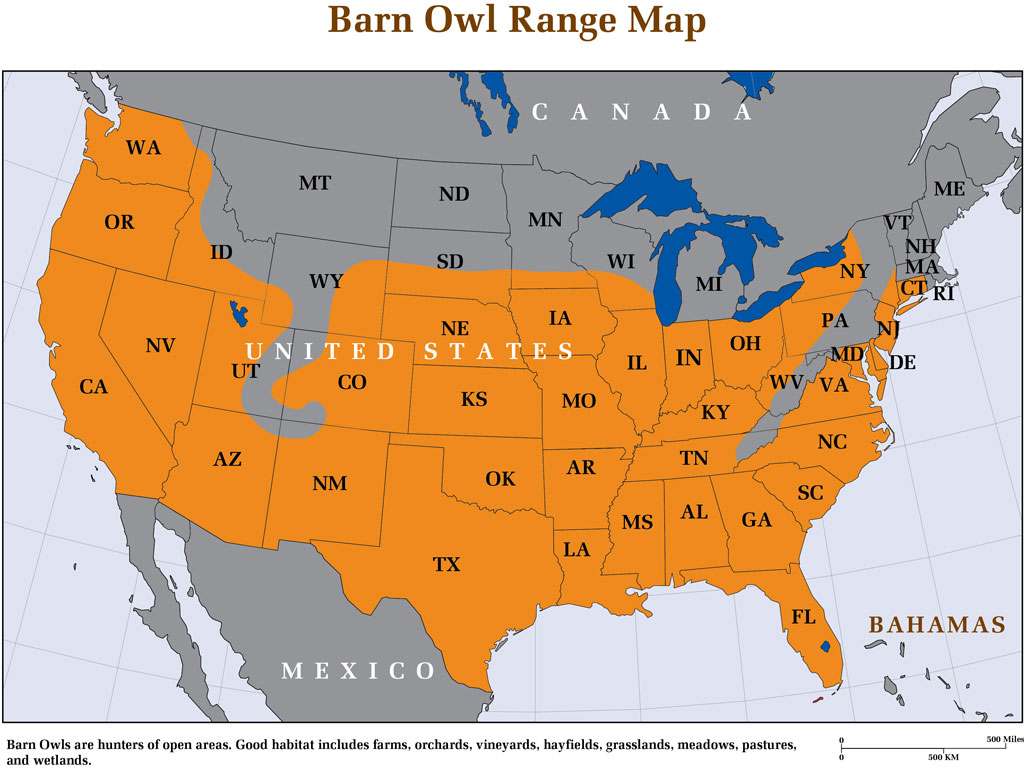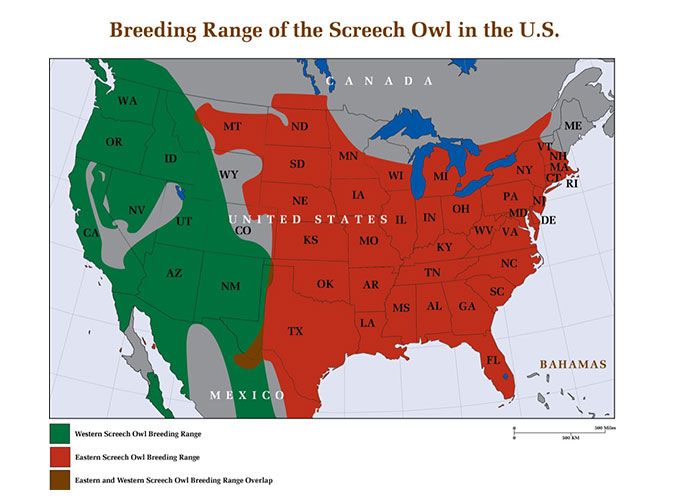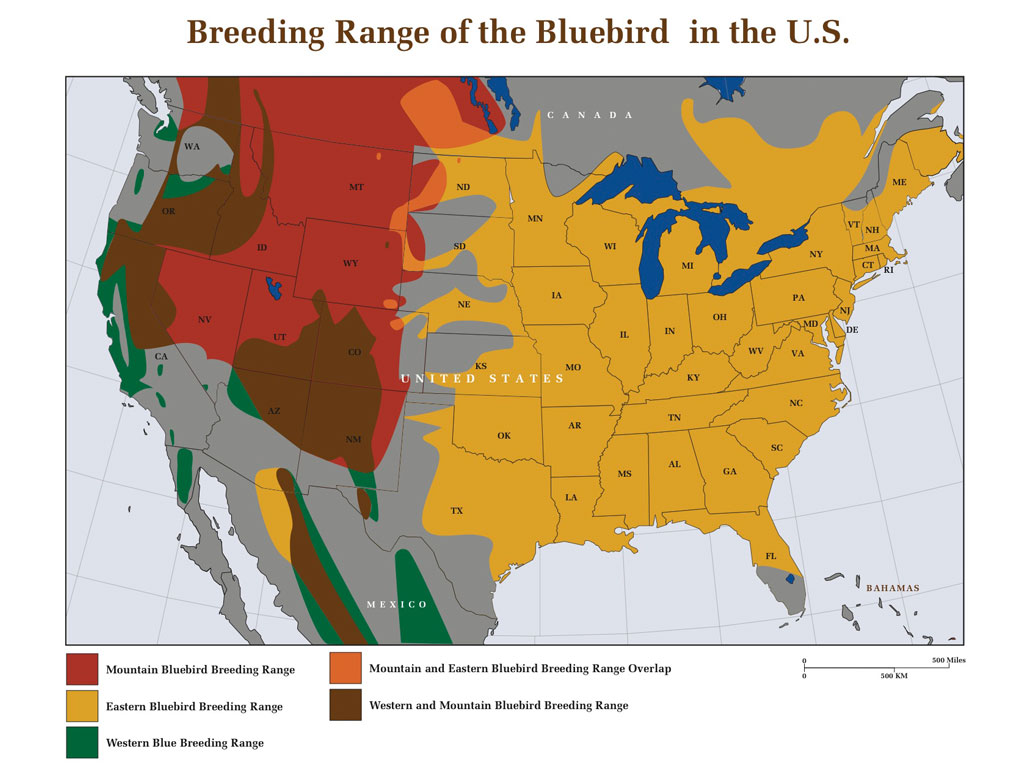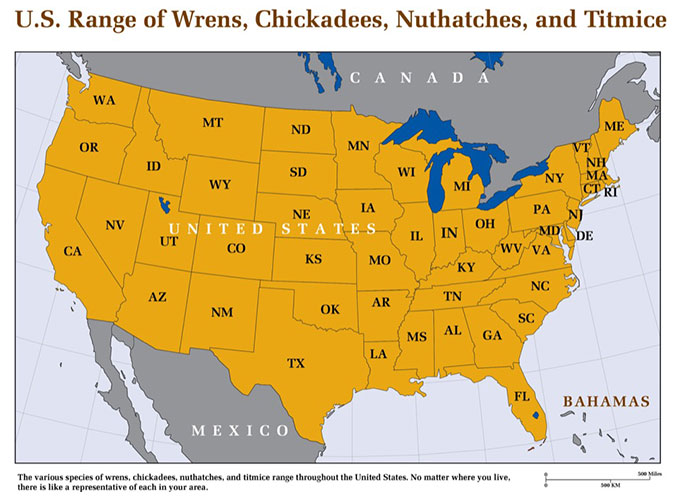Free Shipping to the Contiguous United States
…
Barn Owls by US States
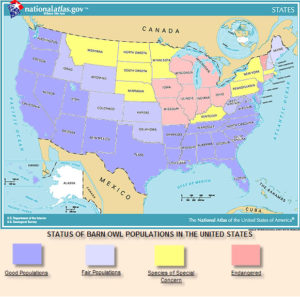 This color-coded map outlines the population status of barn owls throughout the United States.
This color-coded map outlines the population status of barn owls throughout the United States.
Pink: Endangered; these states may have already suffered such losses of barn owls that habitat restoration combined with nest box programs may be necessary to bring back any numbers.
Yellow: Species of Special Concern; these states have seen declining populations. They are excellent states for conservation oriented nest box erection programs in areas of good barn owl habitat.
Light Blue: Fair populations; these states offer excellent opportunities to establish robust populations of barn owls for natural rodent control and integrated pest management.
Dark Blue: Good populations; these states have such high populations of barn owls that nest boxes are inhabited relatively quickly and occupied at relatively high rates. In such states, barn owls will tend to have more than one brood per year. Excellent states to use barn owls in sophisticated rodent control programs.
There are several things to keep in mind while looking at a range map such as the one above.
-
- Even in states that show rare or low populations of barn owls, there may be pockets of populations. Ohio is an excellent example where certain counties have fair numbers. It is these populations that can be expanded through nest box programs.
- Also, some states that have suffered declines may have increasing populations of barn owls due to habitat restoration, such as Pennsylvania where the Pennsylvania State Game Commission is reestablishing many acres of wild grasslands throughout the state. Again, nest box programs in such states are encouraged by wildlife officials.
- In states that show medium to high populations of barn owls, take into account barn owl preferred habitat. Barn owls do not inhabit forests or most cities. For an example, click on the link under the state of Washington below for a typical pattern of barn owl range in a mountainous state.
- Keep in mind that the barn owl is likely more common than suspected in most areas. It is a highly secretive bird, and unlike other owls, calls infrequently except in breeding season. Also keep in mind that barn owl range is very dynamic due to the strong dispersal instinct in the young that disperse for up to hundreds of miles in all directions. Northern young tend to go south, but not strictly—plenty go east, west, and north. This means that those areas in need of bolstering populations receive dispersing barn owls on a regular basis, and if proper habitat has been restored with nesting sites, there is a good chance those barn owls will try to populate those areas.
- For more specific information, find your state below. Some of the states have links to detailed range maps.
Alabama Alaska Arizona Arkansas California Colorado Connecticut Delaware Florida
Georgia Hawaii Idaho Illinois Indiana Iowa Kansas Kentucky Louisiana Maine Maryland Massachusetts Michigan Minnesota Mississippi Missouri Montana Nebraska Nevada
New Hampshire New Jersey New Mexico New York North Carolina North Dakota Ohio
Oklahoma Oregon Pennsylvania Rhode Island South Carolina South Dakota Tennessee
Texas Utah Vermont Virginia Washington West Virginia Wisconsin Wyoming
Alabama Barn Owls – Common throughout the state, recorded in all 67 counties. The Alabama Department of Conservation and Natural Resources website page on barn owls is here: https://www.outdooralabama.com/watchable-wildlife/what/Birds/owls/bo.cfm
Alaska Barn Owls – Barn owls do not occur in Alaska.
Arizona Barn Owls – Common throughout the state, especially in agricultural areas. Rare or absent in the high mountains and forested areas. A link to Arizona Sonora Desert Museum is here www.desertmuseum.org/visit/rff_barnowl.php.
Arkansas Barn Owls – It is probably more common than thought since few population studies have been done. Strong pockets of barn owls are found in various areas of the state, making it an excellent candidate for barn owl nest box projects. Researcher David Clark is asking people to report known barn owl roosts in Northwest Arkansas. He can be contacted at (501) 590-9559 or by e-mail at dwclark@ualr.edu
California Barn Owls – Very common throughout except forests and mountains above 4000 feet. One of the most progressive states in terms of using barn owls for rodent control, California orchards and vineyards have been using them for integrated pest management for decades. An excellent site on using barn owls in vineyards for natural rodent control is here http://tommy51.tripod.com/aboutbarnowls.html
Colorado Barn Owls – Numerous, especially the front range, eastern farmlands, and western agricultural areas. A page from the Colorado Department of Natural Resources is here: http://wildlife.state.co.us/Pages/Home.aspx
Connecticut Barn Owls – Endangered, partly because grasslands and farmlands have declined; however decent populations exist along the coast and in the large river valleys. Access Connecticut info and range map here: http://www.ct.gov/dep/cwp/view.asp?q=325962 . Connecticut’s Department of Environmental Protection encourages residents to erect nest boxes to help bolster the states populations. There is a monitoring and nest box program near Middletown.
Delaware Barn Owls – Good populations around Delaware Bay, along the river valleys and in agricultural areas. Access an article here http://www.owlpages.com/news.php?article=574
Florida Barn Owls – Common throughout. Highly abundant in agricultural areas, especially sugar cane where sugar companies have been using barn owls for controlling cotton rats and roof rats. An excellent article from CNN about barn owls and sugar cane is here: http://edition.cnn.com/EARTH/9706/10/owls/
Georgia Barn Owls – Common throughout. The site for the Georgia Department of Natural Resources is here: http://georgiawildlife.dnr.state.ga.us/content/displaycontent.asp?txtDocument=106
Hawaii Barn Owls – The common barn owl, Tyto alba, was introduced into Hawaii in 1958. Its numbers are excellent, especially around sugar cane farms.
Idaho Barn Owls – Widespread across the southwestern region, rare in the northern mountains but good populations in the Snake River and Clearwater Canyons. Common everywhere except the mountains and forests. Palouse Audubon Society has a good barn owl page here: http://www.palouseaudubon.org
Illinois Barn Owls – Endangered. A permanent resident in the south. A rare permanent resident in north and central. Illinois is one of those states that has been working diligently to bolster barn owl populations–and succeeding–by erecting nest boxes in prime habitat. At one point, only four reported incidences of barn owls were reported to be using nest boxes in state (however one of these pairs raised five broods in 23 months!) Since beginning their nest box program, Illinois Department of Natural Resources reports over 25 nesting pairs and growing. The barn owl page at the Illinois Raptor Center is here: http://www.illinoisraptorcenter.org/Field%20Guide/barnowl.html
Indiana Barn Owls – The conversion of grasslands and wetlands and the cutting of hedgerows and windbreaks for intensive agriculture have contributed to severe declines in this owl that likely was quite common once, particularly in the southern half of the state. State agencies have erected over 200 boxes in recent years with some success and putting up a box in Indiana is an excellent conservation move. The barn owl page on the Indiana Department of Natural Resources is here: http://www.in.gov/dnr/fishwild/3382.htm
Iowa Barn Owls – Endangered. More common in southern half of state. Iowa Department of Natural Resources encourages nest box erection and has been trying for a decade to bolster numbers. Numbers down due to changes in farming: fewer hay and livestock operations, dead hollow trees removed for farming, and metal barns replacing old wooden barns. Excellent article here: http://www.iowabarnfoundation.org/magazine/barn_owls_and_barns.htm
Kansas Barn Owls – Common throughout the state; more populous in the western half. Immense amounts of crop and grassland, including soy, wheat, alfalfa, and dairy as well as tracts of old prairie support good populations. The often tree-less landscape however produces a dearth of nesting sites. Nest boxes would likely be used to a high degree and help bolster populations. The Raptors Roost site: http://www.gpnc.org/owlbarn.htm
Kentucky Barn Owls – The barn owl has declined in Kentucky, and the Kentucky Department of Fish and Wildlife Resources encourages property owners to erect nest boxes. The department has been conducting its own nest box programs with good success and asks residents to report barn owl nesting. Their barn owl page is here: http://fw.ky.gov/navigation.aspx?cid=631&NavPath=C100C366
Louisiana Barn Owls – Very common in coastal marshes, agricultural regions, and open woods. Researchers have found that the rice rat made up over 97% of the prey items in Louisiana marshes. This would lend credibility to the use of barn owls for helping to control these rodents that cause a great deal of economic loss to rice farms in that state and others.
Maine Barn Owls – Rare if not nonexistent. Maine is simply too far north and receives too many deep snows that keep barn owls from surviving the winters.
Maryland Barn Owls – Locally common in agricultural areas throughout most of the state. Almost non-existent in the mountainous far western counties, but with excellent concentrations in central and coastal areas. Maryland Cooperative Extension web page on barn owls is here: http://www.dnr.state.md.us/wildlife/Habitat/WildAcres/wabarnowl.asp
Massachusetts Barn Owls – Over 100 barn owls lived on the island of Nantucket at one point. The barn owl most likely goes through boom and bust in the state, depending on the severity of winters. Nest box programs have been conducted with success. A good article is located here: http://www.owlpages.com/news.php?article=77 . Although recorded throughout the state, it is found mainly along the coastal plain from Newburyport south to Cape Cod and the surrounding islands. It also occurs regularly in the Connecticut and Housatonic River Valleys. There is another good article here: http://www.mass.gov/eea/docs/dfg/nhesp/species-and-conservation/nhfacts/tyto-alba.pdf
Michigan Barn Owls – Declined due to loss of habitat, however state programs are helping, and the state encourages the erection of nest boxes. The conversion of most agricultural systems from pasture-based to intensive row crop along with rodenticides have played a significant role in the population decline. Barn owls should benefit from programs like the Conservation Reserve Program (CRP) that preserve open grassy areas and crop rotations that include a fallow period. An interesting article, which illustrates just how barn owls can be found in states where they are thought not to exist can be found in this article: Michigan Barn Owl
Minnesota Barn Owls – Although there are only a few verified records from the state, chances are that the barn owl was once more common in the southern half. Severe winter weather combined with habitat loss has likely contributed to a statewide scarcity.
Mississippi Barn Owls – Excellent populations exist throughout the state in areas that are not forested, although good numbers also live along the edges of open woodlands. High numbers exist in the lowlands where grain and cotton provide plenty of rodents. A link to Mississippi Wildlife Rehabilitation Inc. is here: www.mswildliferehab.org/AnimalStories/BarnOwls.htm
Missouri Barn Owls – The bird is considered rare in most areas of the state, however the Missouri Department of Conservation encourages the erection of nest boxes. In recent years, Missouri’s DNR has been using barn owl boxes from our company to bolster populations there, fashioning their program after that run by the DNR of Illinois. We expect to see a gradual increase in nesting pairs. If you live in Missouri and would like to help the barn owl population by erecting nest boxes, please call the Missouri Department of Natural Resources to let them know the location of your nest box.
Montana Barn Owls – Good populations in the lower elevations from Kalispell in the Central North down through the southern third of the state. The site for the Montana Natural Heritage Program with a range map is here: http://fieldguide.mt.gov/detail_ABNSA01010.aspx
Nebraska Barn Owls – Barn owls nest throughout the state, with a high concentration in the southwestern counties. The site for Raptor Recovery Nebraska is here: http://www.raptorrecoverynebr.org/
Nevada Barn Owls – Fairly common to common in lower elevation valleys, foothills, and river systems where they inhabit oak savannah and nest in buildings, cavities in cliffs, and hollow trees. Haystacks in Nevada often harbor high concentrations of barn owls which sometimes nest as little as five feet apart. Rehabbers are kept quite busy as hay is loaded onto trucks bound for California, revealing growing broods of owls.
New Hampshire Barn Owls – Almost no information is available on the status of barn owls in New Hampshire. Chances are that the bird is rare in most of the state and that there may be a number along the coast in the southern portion.
New Jersey Barn Owls – Once common throughout the state’s rural areas, populations have plummeted where once productive farmland has been converted to tract housing and development. Good populations still exist along marshes that border the Delaware River in the southern counties. The site of the New Jersey Raptor Trust is here: http://theraptortrust.org/the-birds/owl-facts/barn-owl/
New Mexico Barn Owls – Common throughout except forests and high mountains. A site with some information is here:
http://www.enchantment.coop/features/200810.php
New York Barn Owls – The New York National Heritage Program (website http://www.acris.nynhp.org/guide.php?id=6941) reports that barn owls have declined in New York, but have good populations in at least three areas: Staten Island, Kennedy Airport, and Long Island around Oyster Bay. Nest box programs would likely benefit the barn owl in other areas of the state, particularly the southern and western portions.
North Carolina Barn Owls – Once excellent, populations have shown a recent decline. Many of the young barn owls from the north winter in the Carolinas and some eventually settle there. Good habitat is common throughout the state except for the far western mountainous areas. A link to the Carolina Raptor Center is here Carolina Raptor Center
North Dakota Barn Owls – Rare or non-existent. This is the northern limit of the barn owl’s range due to severe winters.
Ohio Barn Owls – Although the population has declined, there are several areas where barn owls are currently found. This is an excellent state for nest box programs since certain counties have confirmed populations. State biologists report that many barn owls can be found on Amish farms due to the presence of hayfields, horses, and hedgerows. Ohio Department of Natural Resources barn owl page is here: www.ohiodnr.gov/Home/species_a_to_z/SpeciesGuideIndex/barnowl/tabid/6545/Default.aspx
Oklahoma Barn Owls – Although the barn owl is common in many rural areas, there has been a decline. Researcher Stephen Sheffield suggests that this is due to a scarcity of nesting and roosting sites since surveys have shown that their prey have remained abundant from year to year. The Barn Owl Nest Box project has been erecting nest boxes and finding that they are attracting owls successfully. An article about one nest box project is here: http://www.psoklahoma.com/News/releases/viewrelease.asp?releaseID=65
Oregon Barn Owls – As in Washington, barn owls are common along the coast in non-forested areas and throughout the agricultural valleys. Oregon vineyards and orchards are using barn owls for rodent control. An excellent article about the use of barn owls for rodent control in Oregon is here: Using Barn Owls for Rodent Control in the Willamette Valley
Pennsylvania Barn Owls – Although populations have declined severely, the Pennsylvania State Game Commission has been conducted a grassland habitat restoration program which will undoubtedly help numerous field species. A game commission survey of barn owls has revealed more than previously suspected, and it is likely that barn owls will be increasing due to these conservation efforts and nest box programs instituted by non-profits such as Moraine Preservation Fund. The Pennsylvania Game Commission’s website has an excellent page on their Barn Owl Conservation Initiative and who to contact in the state if you have located any barn owls.
Rhode Island Barn Owls – Endangered. Likely to be more common along the coast and river valleys.
South Carolina Barn Owls – There once were excellent populations in the entire state except for the extreme western corner. In recent decades, populations have declined, especially in the Piedmont. Much more common along the coast. The South Carolina Department of Natural Resources has been erecting nest boxes in good habitat. They have a good site on grassland species here: http://www.dnr.sc.gov/cwcs/pdf/Grasslandbirds.pdf
South Dakota Barn Owls – Uncommon. Known barn owl nest sites are scattered and few in number. Although documented from as far west as Fall River County, most nests have been found in natural cavities in banks of the Missouri River’s reservoirs and adjacent drainages. Not much is known about the true distribution or abundance of South Dakota’s nesting barn owls. The barn owl has been known to excavate sites in soft substrate in the Sand Hills. The website of the South Dakota Natural Heritage Program encourages the erection of nest boxes.
Tennessee Barn Owls – More common in the central and eastern portions. The population of barn owls may be declining as farmlands, with their open grassland habitats such as hayfields and pastures, disappear. In Tennessee, the barn owl has been designated as a species in need of management. An excellent state for conservation measures such as habitat preservation and nest box installation. State biologist Scott Somershoe has been organizing barn owl nest box construction. Call 615-862-4187. Several other biologists are working to install nest boxes in prime habitat. http://www.tnwatchablewildlife.org/details.cfm?displayhabitat=grassland&sort=aounumber&typename=GRASSLAND%20AND%20SHRUB&uid=09041919141752583&commonname=Barn%20Owl
Texas Barn Owls – Common throughout Texas. A good number of farms and ranches have erected nest boxes with excellent results. A newspaper article on Texas barn owls is here: www.lubbockonline.com/stories/102608/col_348426055
Utah Barn Owls – Common throughout except forests. Plenty of good studies have been done in Utah, revealing a good population, some records of fall nesting, and burrowing in riverbanks for nest holes. Utah Department of Natural Resources barn owl page: http://www.dwrcdc.nr.utah.gov/rsgis2/search/Display.asp?FlNm=tytoalba
Vermont Barn Owls – Rare. In the 1985 Breeding Bird Atlas, four pairs were documented. As in Maine, the severe winters limit populations.
Virginia Barn Owls – Common on the coastal plain and very robust populations along the coast and Chesapeake Bay. Rare in the mountainous western edge of the state. Good concentrations in the Shenandoah Valley. Researchers there report that old silos are a frequent nesting site and that barn owls actually burrow hollows in the old silage to lay their eggs and raise their chicks.
Washington Barn Owls – Common permanent residents in the lower, unforested areas of the state, namely along the coast, in the eastern lowlands, the Columbia Valley, and most of western Washington. High concentrations in Puget Sound and the Columbia Valley. They are being used for rodent control by vineyards and orchards. For an excellent range map visit http://www.birdweb.org/birdweb/bird/barn_owl.
Bird Web
West Virginia Barn Owls – Common in agricultural and open grassy areas, but nonexistent in the forested mountains. They apparently have been increasing, in part due to a nest box program. Also, abandoned strip mines turned to grasslands have increased populations, although these lands could well benefit from nest box installation. You can access a good article here that gives phone numbers of state biologists interested in increasing populations: http://news.google.com/newspapers?nid=1011&dat=20010830&id=UzclAAAAIBAJ&sjid=dxEGAAAAIBAJ&pg=759,279940
Wisconsin Barn Owls – Endangered. Barn owls generally live only in the southern third of the state. Although Wisconsin’s barn-owl population was never high, a decrease in sightings since the 1950s suggests that it has been declining. Barn owls were placed on the Wisconsin Endangered Species List in 1979. At present, the status of the population in Wisconsin is unknown. Found in small numbers north to Polk, Clark, Vilas and Marinette counties, which is the edge of their northern range in Wisconsin. The Wisconsin Bird Conservation Initiative has a good site and a range map here: http://www.wisconsinbirds.org/plan/species/bnow.htm
Wyoming Barn Owls – Common throughout the state except in forests. Often nests in abandoned mines, sometimes nesting as far as one hundred feet below the surface.

